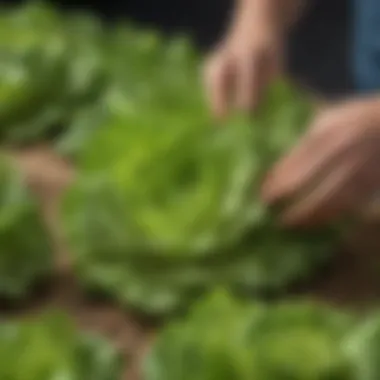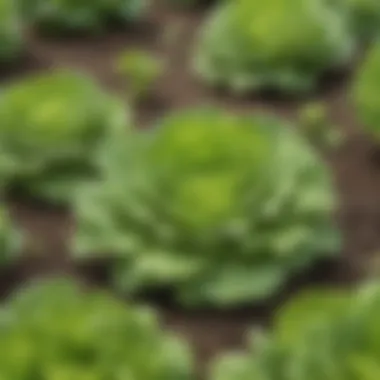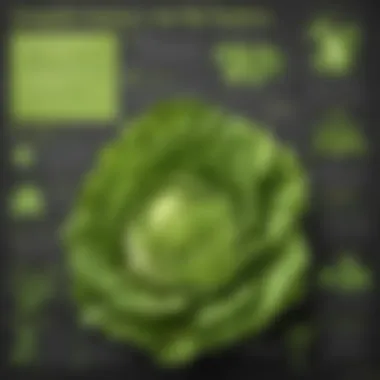Understanding the Regrowth of Lettuce: A Detailed Exploration


Intro
Growing lettuce isn’t just about planting seeds and watering them. It’s a dynamic process full of intriguing biological mechanisms and practical methods. This guide dives into the fascinating world of lettuce regrowth, exploring the steps, challenges, and benefits.
First off, let’s clarify what we mean by regrowth. When we say regrowth, it often refers to how certain plants can replenish themselves after being cut or harvested. Lettuce, a leafy green that many of us enjoy in salads, sandwiches, and wraps, has a special way of regenerating after it has been harvested. This process isn't only interesting but also handy for those who prefer to grow their own greens at home. From organic backyard gardens to urban balcony pots, understanding and perfecting lettuce regrowth can provide not just foliage but also a sense of accomplishment.
Science Fun Facts
Lettuce isn’t just any old green. It carries a bag full of unique features and fascinating tidbits! Here are some interesting facts that showcase the plant's wonders:
- Varietal Diversity: Did you know there are over 100 different varieties of lettuce? From crisp romaine to tender butterhead, each type has its unique flavor and texture.
- Historical Roots: Lettuce was cultivated by the ancient Egyptians and was known in ancient Roman times. It was even reputed to have calming properties!
- Hydration Hero: Lettuce contains about 95% water, making it a hydrating choice for your meals.
These are just a few quirky insights to ponder while tending to your lettuce. But beyond trivia lies the beauty of the science behind the regrowth process, which we'll explore further in the upcoming sections.
Preface to Lettuce Regrowth
Lettuce regrowth is more than just a gardening curiosity; it bridges the gap between sustainability and everyday kitchen practices. When you cut a lettuce head from your garden or even from the supermarket, you can often save the base—and a little water—allowing it to sprout anew. This simple act not only empowers home gardeners but also serves as a testament to nature's ability to regenerate. Understanding the nuances of lettuce regrowth can advance a gardener's skills and strengthen their connection to food cultivation.
Importance of Regrowth
The beauty of regrowing lettuce is rooted in its simplicity. With just a bit of care, a few scraps thrown into water can transform into a vibrant green plant. Here are important reasons to consider this practice:
- Saves Money: By regrowing lettuce, you’re not just reducing your grocery bill; you're also taking advantage of food that would otherwise be wasted.
- Freshness at Your Fingertips: Having a continuous supply of lettuce encourages healthier eating habits. Imagine plucking fresh greens right from your kitchen counter!
- Educational Experience: For young children, watching lettuce regrow can ignite a love for gardening and an interest in where food comes from.
As you embark on this journey of regrowth, you create more than just plants; you cultivate an appreciation for the environment and sustainable practices.
Overview of Lettuce Varieties
When it comes to lettuce, variety is the spice of life. Understanding which types can be regrown and their unique characteristics can enhance your gardening experience. Here are some popular types:
- Romaine Lettuce: Thick, crunchy leaves make it a favorite in salads. Romaine is known for its robust flavor and is quite resilient in regrowth.
- Butterhead Lettuce: Soft and tender, this variety typically regrows slower than others but offers rich flavors. Their tight head makes them ideal for wraps.
- Leaf Lettuce: These grow in loose formations and are easy to harvest. Leaf lettuce is particularly forgiving during the regrowth phase, providing multiple leaves quickly.
Choosing the right variety matters as not all lettuces wilt at the same rate. Some may thrive better in your specific climate or even indoors. Knowing your options can arm you with the knowledge to make your lettuce garden thrive.
Biological Mechanisms of Regrowth
The biological mechanisms of regrowth in lettuce are foundational to understanding how this leafy vegetable returns to life after being harvested. For many, there is a curiosity about how plants can almost magically regenerate. This process is not just fascinating but also vital for anyone interested in sustaining their home garden. Recognizing the intricate balance between plant biology and cultivation can significantly enhance one’s gardening experience.
Photosynthesis in Lettuce
Photosynthesis is a plant's method of converting sunlight into energy. For lettuce, this process starts when sunlight hits the chlorophyll within its leaves. Chlorophyll, that green pigment so common in leafy veggies, plays a crucial role. It absorbs sunlight and facilitates the conversion of carbon dioxide from the air and water from the soil into glucose—a form of sugar that serves as food for the plant.
Think of it like a chef preparing a meal. The sunlight is the cooking heat, carbon dioxide represents the fresh ingredients, and water is like the boiling pot. When all these elements combine, the result is sustenance that allows lettuce to grow and thrive. This makes photosynthesis not just important but indispensable for regrowth. Without enough sunlight, the lettuce wouldn’t be able to produce the energy it requires to sprout back to life.
"The green leaves of lettuce aren't just pretty; they're powerhouses of energy production."
Key factors influencing photosynthesis in lettuce include:
- Light Intensity: Bright, direct sunlight offers the best results, though lettuce can tolerate partial shade.
- Water Availability: Adequate moisture is essential. Too little or too much water can hamper this process.
- Temperature: Lettuce prefers milder temperatures; extremes can slow down photosynthesis and affect growth.


Root Development and Nutrient Uptake
Roots play a critical role in replenishing lettuce after it's been harvested. They are not just anchors but also serve as the primary means through which plants absorb essential nutrients and water from the soil. When planting lettuce stubs, it’s crucial to remember that the root systems need to be intact for successful regrowth.
As the roots dig deeper, they explore the soil for nutrients like nitrogen, phosphorus, and potassium. These elements are necessary for robust lettuce growth. Each nutrient serves a unique purpose:
- Nitrogen helps in the growth of leaves, which is of utmost importance for leafy vegetables like lettuce.
- Phosphorus plays a vital role in energy transfer and root development, giving lettuce the solid base it needs to thrive.
- Potassium aids in overall plant function, impacting everything from water regulation to disease resistance.
Compounding this, the soil’s structure should not be overlooked; loose, well-aerated soil allows for more vigorous root growth. Letting a little air into the mix is like giving the plant its own personal spa day.
Preparing to Regrow Lettuce
In the journey of lettuce regrowth, preparation stands as the foundation that paves the way for success. Understanding what needs to be done before planting will not only save time but also ensure that you are set up for a thriving crop. From picking the right variety to knowing what tools and conditions you need, each decision plays a critical role in the overall success of your efforts.
Getting those basics right means you can transform leftover lettuce stubs into gorgeous green leaves again. Let’s dive into the key aspects of preparing to regrow lettuce.
Selecting the Right Lettuce
When looking to regrow lettuce, not every variety will give you the same results. Some types are known to bounce back quicker than others. For example, romaine and green leaf lettuces typically fare quite well in the regrowth process. They tend to produce luscious leaves with minimal effort.
On the other hand, varieties like butterhead or tougher types might demand a little more attention. Here are some helpful pointers you might consider when selecting your lettuce:
- Look for Fresh Stubs: The healthiest stubs are the ones that were just cut. They should still look vibrant and not too wilted.
- Avoid Any Signs of Damage: Don't pick stubs from heads that are brown or mushy. This can lead to a failed regrowth attempt.
- Think About Your Needs: Want a crunchy salad or a fresh sandwich? The variety you select might just determine how tasty your future salads will be.
Optimal Climate Conditions
Climate plays a massive role in the regrowth of lettuce. These leafy greens are quite the divas when it comes to their comfort zone. Ideally, lettuce prefers mild temperatures. A sweet spot around 60-70 °F (15-21 °C) is considered perfect. Here are a couple of things to keep in mind:
- Too Hot? Too Cold?: Lettuce does not take well to scorching weather; it might bolt (flower) if temperatures exceed 75 °F (24 °C). Conversely, cold can stunt its growth.
- Light Exposure: Aim for a spot that receives ample indirect sunlight. Four to six hours of light a day can do wonders. If you're indoors, a bright windowsill can be ideal.
- Humidity Levels: Lettuce enjoys humid surroundings, but don’t drown it. Aim for a damp atmosphere, but ensure good drainage.
Necessary Tools and Materials
Now that you’ve picked your lettuce and assessed the climate, it’s time to gather the tools and materials that will make regrowing a breeze. Here’s a checklist:
- Container: A small pot or even a glass can work well for nurturing lettuce stubs.
- Soil: Use a potting mix or a soil type that drains well. Look for something that can retain a bit of moisture without becoming soggy.
- Watering Can or Spray Bottle: Ideal for keeping the stubs moist but not drowned.
- Scissors or Knife: For cutting the lettuce accurately, ensuring you leave just the right amount of stem.
- Sunlight Filter: Optional, but using sheer cloth to filter sunlight can help if you find your setup too bright for the lettuce.
Remember: Preparation saves effort down the road and ensures your regrowth endeavor is as successful as a well-timed tomato harvest.
Step-by-Step Process for Regrowing Lettuce
Regrowing lettuce might sound simple, but there’s a whole world of detail involved. This process isn’t just about sticking a few scraps in the soil and hoping for the best. Understanding the finer points can lead to better results and a more satisfying gardening experience. By learning the step-by-step process, even novice gardeners can see great success.
Initial Preparation of Lettuce Stubs
The journey to regrow starts with the preparation of the lettuce stubs. Once you’ve enjoyed that crispy salad or delicious sandwich, don’t throw the stem away! Cut the lettuce, leaving a few inches of the base intact. This part is where the magic happens.
Before placing the stubs in water or soil, rinse them lightly. This helps to remove any debris or remnants of the old leaves. Next, find a shallow dish or container to hold the stubs.
- Cut cleanly – Ensure your knife is sharp to avoid crushing the stub.
- Leave some leaves – If you have some leaf base, that’s better as it has some nutrients to start the regrowth.
- No wilted leaves – Start with fresh stubs; old and wilting ones won’t produce much.
Once the preparation is done, let’s move on to the next stage which is all about keeping your stubs well-hydrated and in the right light.


Water and Light Requirements
When it comes to regrowing lettuce, water and light are critical players. Just like us, lettuce needs the right environment to thrive.
Watering
- The stubs should be partially submerged in water if you’re using a water regrowth method. Change the water every couple of days to keep it fresh, and watch for signs that it needs more hydration—excessive browning could be a warning sign.
- If you plant them in soil, make sure the soil remains moist but not waterlogged. Lettuce roots are delicate and can rot if they sit in too much water.
Light
- Bright, indirect sunlight is ideal. Too much direct sun can scorch the tender leaves, causing them to wilt. A south or east-facing window often provides an excellent vantage point for growth.
- If natural light is scarce, consider adding a grow light to ensure they get all the light they need. An easy rule is about 12 hours of light daily; think of it as their sunshine siesta!
Timing and Growth Monitoring
Timing is everything when it comes to regrowing lettuce. Patience may not be a gardener’s strongest suit, but it’s crucial.
- Observation – Regularly check your stubs. You'll likely see little leaves sprouting within a week or two, signaling that your hard work is paying off.
- Measure Growth – Don't hesitate to keep a little log or notebook to track when you planted the stubs, the size of the leaves, and any observations you make. This can help in understanding just how quickly they are growing and when to collect.
- Harvest Timing – Once the leaves are about 4 to 6 inches long, you can start to harvest. Trim top leaves while leaving some behind for continued regrowth.
In summary, regrowing lettuce is a blend of art and science, requiring attention to detail. Taking the time to prepare your lettuce stubs, ensuring proper light and water, and keeping an eye on growth patterns will yield a bountiful harvest and fewer headaches.
"Regrowing lettuce is not just about nutrition; it's a gratifying experience connecting us more deeply with the food we eat."
Don't miss out on the small victories and learning moments along the way. Happy gardening!
Nutritional Benefits of Regrown Lettuce
Regrowing lettuce is not just about watching those lusciously green leaves spring back to life. It’s also about tapping into a treasure trove of vitamins and minerals that can shine a bright light on our health. In the hustle and bustle of life, knowing the nutritional perks of lettuce can remind us why these leafy greens deserve a special spot in our daily meals.
Vitamins and Minerals in Lettuce
Lettuce is packed with a smorgasbord of essential vitamins and minerals. These nutrients are like the tiny superheroes working behind the scenes, making sure our bodies function at their best. Here’s a rundown of some key players:
- Vitamin A: Just a handful of leafy greens can provide a big boost to your vitamin A levels, which is crucial for good vision and a healthy immune system.
- Vitamin K: This vitamin supports proper blood clotting and bone health. Some would even say it’s a good companion for calcium in keeping bones strong.
- Folate: Another gem found in lettuce, folate, helps in synthesizing DNA, making it especially important for cell division. It’s vital during pregnancy since it supports fetal development.
- Potassium: An essential mineral that plays a key role in heart health, potassium aids in maintaining proper fluid balance and regulating blood pressure.
- Dietary Fiber: While not a vitamin or mineral, fiber is something to cheer about! It helps with digestion and can contribute to a sense of fullness, keeping unhealthy snacking at bay.
These nutrients mean lettuce is a low-calorie powerhouse that can easily fit into a balanced diet. Next time you chop off the end of a lettuce head, think about how much you might be gaining back when you regrow it.
Health Benefits of Regular Consumption
Eating regrown lettuce can be seen as an easy way to amp up your diet with fresh, nutritious greens on a regular basis. Here’s how munching on this veg can help:
- Supports Skin Health: The vitamins in lettuce can contribute to healthy skin. The hydration you get from eating it may even make your skin appear more vibrant.
- Aids Digestion: With its high water content and fiber, lettuce can help keep your digestion running smoothly. It's like a gentle push through the digestive tract, easing any troubles along the way.
- Promotes Weight Management: Being low in calories yet high in volume, lettuce can fill you up without weighing you down. This makes it a great option for those looking to manage weight while still enjoying their meals.
- Enhances Mental Wellbeing: There is some evidence suggesting that magnesium, found in certain types of lettuce, may play a part in stabilizing mood and reducing anxiety. So the next time you toss a salad, remember it could be good for your brain too.
"Incorporating more leafy greens into your diet can lead to profound health improvements, one crunchy bite at a time."
Overall, the nutritional benefits of regrown lettuce make it an essential addition to the diet. Watching it grow can be rewarding, but, more importantly, reaping its health benefits might just transform how you think about your meals.
Common Challenges and Solutions
When it comes to growing lettuce, while the allure of fresh leaves might seem simple, some challenges can emerge along the way. Addressing these hurdles effectively is key not only for the plant's health but also for a successful harvest. Here, we’ll dive into the intricacies of pest management and environmental factors that can greatly affect lettuce growth. Understanding these elements ensures a more fruitful gardening experience, minimizing potential setbacks.
Pest Management Strategies


Lettuce faces its fair share of pests, and knowing how to handle them can make a world of difference. Common culprits include aphids, slugs, and whiteflies. These little critters can wreak havoc, sucking the nutrients from the leaves and stunting growth. Here's a look at some strategies to manage pests effectively:
- Companion Planting: Growing plants alongside your lettuce can deter pests. For example, planting marigolds can repel aphids, while basil can enhance the flavor of the lettuce itself.
- Natural Predators: Encourage natural predators like ladybugs and lacewings. These beneficial insects will munch on pests and help keep your lettuce safe.
- Neem Oil: This natural pesticide comes from the seeds of the neem tree. Spraying a diluted solution on the affected plants can control pest populations without harming beneficial insects.
- Regular Monitoring: Keep your eyes peeled for the first signs of pest activity. Early intervention can save your plants from excessive damage.
"A stitch in time saves nine" - addressing pest issues sooner rather than later can save your crop.
Using these strategies regularly helps maintain a healthy lettuce patch. Consistency and vigilance go hand in hand in safeguarding your plants from unwanted guests.
Environmental Factors Affecting Growth
The environment around your lettuce plays a massive role in how well your plants can thrive. Factors such as temperature, humidity, and light all influence growth rates. Here are some critical points to consider:
- Temperature: Lettuce grows best in cool weather. Ideal temperatures range from 60°F to 70°F. Too much heat can cause the plants to bolt, flowering prematurely and leaving you with bitter leaves.
- Light: Lettuce needs adequate sunlight but not too intense. About 12 to 14 hours of indirect light a day is often beneficial. In places with harsh sunlight, consider using shade cloth to protect your growing lettuce.
- Soil Moisture: Consistent soil moisture is vital. Lettuce has shallow roots, and dry spells can lead to wilting. Aim for well-draining soil that retains moisture without becoming soggy.
By taking environmental factors into account, you can create the ideal conditions for your lettuce, thereby enhancing growth and improving yields.
Sustainability and Environmental Impact
Sustainability in agriculture is not just a buzzword; it's a crucial principle that addresses how we produce food while preserving our planet. When it comes to regrowing lettuce, the role of sustainability takes center stage. This topic intertwines with several significant elements, such as resource conservation, environmental health, and food security.
Regrowing Lettuce as a Sustainable Practice
Regrowing lettuce can be seen as a poster child for sustainable gardening. By using lettuce scraps to produce new plants, gardeners can conserve both water and space. For instance, the process is simple: cut the base of the lettuce head and place it in water. As the days pass, you will be astonished to see the roots unfurl and new leaves sprouting.
- Space Efficient: Regrowth requires only a small area, making it ideal for urban gardens where space is often at a premium.
- Water Conservation: By relying on water from the cutting stage, you significantly reduce the need for excessive watering. It’s like hitting two birds with one stone!
- Cost-Effective: Less spending on seeds means more savings. At the same time, there's no need to buy lettuce from the store, which often involves excess packaging and transportation costs.
This way of gardening reinforces the idea of utilizing what we often discard. It not only promotes a healthy ecosystem but also fosters a practical, hands-on way of engaging with food production.
Reducing Food Waste through Regrowth
Food waste is a substantial concern worldwide; it's estimated that about one-third of all food produced goes uneaten. By regrowing lettuce, we can play our part in addressing this issue.
- Creative Solution to Waste: Instead of throwing away the base of the lettuce, which is usually thrown in the trash, you give it a second chance at life. This practice not only benefits you but also reduces the waste that ends up in landfills.
- Educational Opportunity: Engaging children in this activity teaches them the importance of waste reduction. Having them participate can foster a sense of responsibility towards food and the environment, making for a powerful learning experience.
- Community Engagement: Sharing regrown produce among neighbors can strengthen community ties. Imagine exchanging tips over a fresh head of lettuce grown from a discarded piece!
Regrowing lettuce directly contributes to a more circular economy. Each small action adds up, creating a ripple effect that can lead to significant changes in how we treat food and resources.
"Every food scrap saved can contribute towards a healthier planet; that’s the beauty of regrowing lettuce."
Closure and Future of Lettuce Cultivation
Regrowing lettuce not only reflects the resilience of nature but also underscores how gardening can tie into broader themes of sustainability and innovation. As we've explored throughout this article, the journey of lettuce from scraps to vibrant greens goes beyond nutrition; it embodies an approach to living harmoniously with our environment. The practice of regrowing lettuce emphasizes the inherent benefits of recycling food waste, leading to a smaller carbon footprint and a more sustainable lifestyle.
Final Thoughts on Regrowing Lettuce
To wrap things up, regrowing lettuce is more than just a hobby; it's a chance to be part of a world aiming to minimize waste while maximizing health benefits. Whether you're struggling to keep your plants alive or you're new to gardening, the simplicity of regrowing lettuce from stubs stands as an achievable goal. The next time you finish a salad, consider placing those healthy leftover stubs in a bit of water and see what happens. You may find joy in watching them thrive.
"The best time to plant a tree was twenty years ago. The second-best time is now." – Chinese Proverb
When we consider the time and effort that goes into cultivating lettuce, it becomes even clearer that this practice of regrowth is something everyone can embrace. It teaches responsibility, nurturing, and patience while presenting a tangible reward: fresh greens at our fingertips.
The Role of Innovation in Plant Propagation
Looking forward, we can expect innovation to play a critical role in how we engage with lettuce cultivation and gardening in general. From advancements in hydroponics to automated systems that manage optimal growing conditions, technology is weaving its way into everyday gardening. This not only improves efficiency but also invites more people to participate even amidst urban constraints.
These modern techniques could revolutionize the way we think about food production in limited spaces, making fresh produce accessible to communities everywhere. Farmers will likely enhance their practices through research and community engagement, learning from both successes and failures, effectively creating a cycle of continuous improvement.
Furthermore, ongoing education about sustainable practices and more thoughtful consumer choices will amplify the benefits of regrowing lettuce. Schools and community gardens can foster a new generation of environmentally-conscious individuals who understand the delicate balance of our ecosystem.







